What is it about?
The objective of the present study was to evaluate physical activity levels during the pregnancy and postpartum periods and the influence of body mass index (BMI) in women with gestational diabetes mellitus (GDM) or low risk pregnancy.
Featured Image

Photo by Dane Wetton on Unsplash
Why is it important?
Considering the evident need to elaborate and integrate exercise programs in prenatal care that combine effectiveness and greater adherence of the pregnant population, it is essential to estimate the level of physical activity (PA) in the population at low and intermediate obstetric risk, as well as to identify the variables that contribute to this scenario.
Perspectives
In the present study, neither BMI nor a diagnosis of GDM interfered with the PA level of pregnant women. On the other hand, the time factor, specifically the postpartum period, determined higher PA levels when compared to preconception and pregnancy in both women with low-risk pregnancy and women with a diagnosis of GDM. Despite the statistical difference, there was no clinical relevance in the MET’s difference because the patients still remained on the sedentary physical activity level according to PPAQ. In view of the growing sedentary PA level in the population studied, the importance of exercise for the prevention and treatment of GDM and the severe complications of hyperglycemia, the development of public health policies providing safer instructions and exercise programs for pregnant women should be reinforced.
Elaine Christine Dantas Moises
Universidade de Sao Paulo Campus de Ribeirao Preto
Read the Original
This page is a summary of: Do the body mass index and the diagnosis of gestational diabetes mellitus influence the level of physical activity during pregnancy and postpartum?, PLoS ONE, August 2019, PLOS,
DOI: 10.1371/journal.pone.0220947.
You can read the full text:
Contributors
The following have contributed to this page










